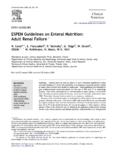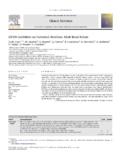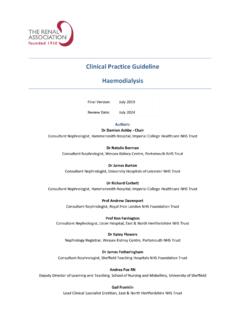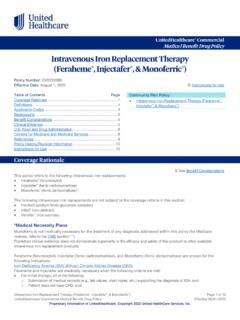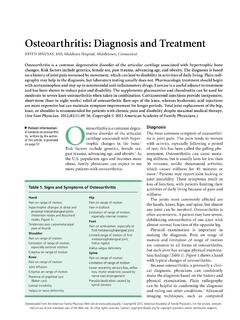Transcription of SUMMARY OF PRODUCT CHARACTERISTICS
1 1 ANNEX ISUMMARY OF PRODUCT CHARACTERISTICS21. NAME OF THE MEDICINAL PRODUCTKEYTRUDA 25 mg/mL concentrate for solution for QUALITATIVE AND QUANTITATIVE COMPOSITIONOne vial of 4 mL of concentrate contains 100 mg of mL of concentrate contains 25 mg of is a humanised monoclonal anti-programmed cell death-1 (PD-1) antibody(IgG4/kappa isotype with a stabilising sequence alteration in the Fc region) produced in Chinesehamster ovary cells by recombinant DNA the full list of excipients, see section PHARMACEUTICAL FORMC oncentrate for solution for to slightly opalescent, colourless to slightly yellow solution, pH .4. CLINICAL Therapeutic indicationsMelanomaKEYTRUDA as monotherapy is indicated for the treatment of advanced (unresectable or metastatic)melanoma in as monotherapy is indicated for the adjuvant treatment of adults with Stage IIImelanoma and lymph node involvement who have undergone complete resection (see section ).
2 Non -small cell lung carcinoma (NSCLC)KEYTRUDA as monotherapy is indicated for the first-line treatment of metastatic non-small cell lungcarcinoma in adults whose tumours express PD-L1 with a 50% tumour proportion score (TPS) withno EGFR or ALK positive tumour , in combination with pemetrexed and platinum chemotherapy, is indicated for the first -line treatment of metastatic non-squamous non -small cell lung carcinoma in adults whose tumourshave no EGFR or ALK positive , in combination with carboplatin and either paclitaxel or nab -paclitaxel, is indicated forthe first -line treatment of metastatic squamous non -small cell lung carcinoma in as monotherapy is indicated for the treatment of locally advanced or metastaticnon -small cell lung carcinoma in adults whose tumours express PD-L1 with a 1% TPS and whohave received at least one prior chemotherapy regimen.
3 Patients with EGFR or ALK positive tumourmutations should also have received targeted therapy before receiving Hodgkin lymphoma (cHL)KEYTRUDA as monotherapy is indicated for the treatment of adult and paediatric patients aged3 years and older with relapsed or refractory classical Hodgkin lymphoma who have failed autologousstem cell transplant (ASCT) or following at least two prior therapies when ASCT is not a carcinomaKEYTRUDA as monotherapy is indicated for the treatment of locally advanced or metastaticurothelial carcinoma in adults who have received prior platinum-containing chemotherapy (seesection ).KEYTRUDA as monotherapy is indicated for the treatment of locally advanced or metastaticurothelial carcinoma in adults who are not eligible for cisplatin-containing chemotherapy and whosetumours express PD-L1 with a combined positive score (CPS) 10 (see section ).
4 Head and neck squamous cell carcinoma (HNSCC)KEYTRUDA, as monotherapy or in combination with platinum and 5-fluorouracil (5-FU)chemotherapy, is indicated for the first-line treatment of metastatic or unresectable recurrent head andneck squamous cell carcinoma in adults whose tumours express PD-L1 with a CPS 1 (seesection ).KEYTRUDA as monotherapy is indicated for the treatment of recurrent or metastatic head and necksquamous cell carcinoma in adults whose tumours express PD-L1 with a 50% TPS and progressingon or after platinum-containing chemotherapy (see section ).Renal cell carcinoma (RCC)KEYTRUDA, in combination with axitinib, is indicated for the first-line treatment of advanced renalcell carcinoma in adults (see section ).KEYTRUDA, in combination with lenvatinib, is indicated for the first-line treatment of advancedrenal cell carcinoma in adults (see section ).
5 KEYTRUDA as monotherapy is indicated for the adjuvant treatment of adults with renal cellcarcinoma at increased risk of recurrence following nephrectomy, or following nephrectomy andresection of metastatic lesions (for selection criteria, please see section ).Colorectal cancer (CRC)KEYTRUDA as monotherapy is indicated for the first-line treatment of metastatic microsatelliteinstability-high (MSI-H) or mismatch repair deficient (dMMR) colorectal cancer in carcinomaKEYTRUDA, in combination with platinum and fluoropyrimidine-based chemotherapy, is indicatedfor the first-line treatment of locally advanced unresectable or metastatic carcinoma of the oesophagusor HER-2 negative gastroesophageal junction adenocarcinoma in adults whose tumours expressPD-L1 with a CPS 10 (see section ).Triple-negative breast cancer (TNBC)KEYTRUDA, in combination with chemotherapy, is indicated for the treatment of locally recurrentunresectable or metastatic triple-negative breast cancer in adults whose tumours express PD-L1 with aCPS 10 and who have not received prior chemotherapy for metastatic disease (see section ).
6 Endometrial carcinoma (EC) KEYTRUDA, in combination with lenvatinib, is indicated for the treatment of advanced or recurrentendometrial carcinoma in adults who have disease progression on or following prior treatment with aplatinum-containing therapy in any setting and who are not candidates for curative surgery Posology and method of administrationTherapy must be initiated and supervised by specialist physicians experienced in the treatment ofcancer. 4PD-L1 testingIf specified in the indication, patient selection for treatment with KEYTRUDA based on the tumourexpression of PD-L1 should be confirmed by a validated test (see sections , , , and ).MSI -H/dMMR testing for patients with CRCFor treatment with KEYTRUDA as monotherapy, testing for MSI-H/dMMR tumour status using avalidated test is recommended to select patients with CRC (see sections and ).
7 PosologyThe recommended dose of KEYTRUDA in adults is either 200 mg every 3 weeks or 400 mg every6 weeks administered as an intravenous infusion over 30 recommended dose of KEYTRUDA as monotherapy in paediatric patients aged 3 years and olderwith cHL is 2 mg/kg bodyweight (bw) (up to a maximum of 200 mg), every 3 weeks administered asan intravenous infusion over 30 use in combination, see the SUMMARY of PRODUCT CHARACTERISTICS (SmPC) for the should be treated with KEYTRUDA until disease progression or unacceptable toxicity (andup to maximum duration of therapy if specified for an indication). Atypical responses ( an initialtransient increase in tumour size or small new lesions within the first few months followed by tumourshrinkage) have been observed. It is recommended to continue treatment for clinically stable patientswith initial evidence of disease progression until disease progression is the adjuvant treatment of melanoma or RCC, KEYTRUDA should be administered until diseaserecurrence, unacceptable toxicity, or for a duration of up to one delay or discontinuation (see also section )No dose reductions of KEYTRUDA are recommended.
8 KEYTRUDA should be withheld ordiscontinued to manage adverse reactions as described in Table 1: Recommended treatment modifications for KEYTRUDAI mmune-related adversereactionsSeverity Treatment modification PneumonitisGrade 2 Withhold until adverse reactionsrecover to Grades 0-1*Grades 3 or 4, or recurrent Grade 2 Permanently discontinue Colitis Grades 2 or 3 Withhold until adverse reactionsrecover to Grades 0-1*Grade 4 or recurrent Grade 3 Permanently discontinue Nephritis Grade 2 with creatinine > to 3 times upper limit of normal (ULN) Withhold until adverse reactionsrecover to Grades 0-1*Grade 3 with creatinine > 3 times ULN Permanently discontinue Endocrinopathies Grade 2 adrenal insufficiency and hypophysitis Withhold treatment untilcontrolled by hormonereplacement5 Immune-related adversereactionsSeverity Treatment modificationGrades 3 or 4 adrenal insufficiencyor symptomatic hypophysitisType 1 diabetes associated with Grade 3 hyperglycaemia (glucose > 250 mg/dL or > mmol/L)
9 Or associated with ketoacidosis Hyperthyroidism Grade 3 Withhold until adverse reactionsrecover to Grades 0-1*For patients with Grade 3 orGrade 4 endocrinopathies thatimproved to Grade 2 or lowerand are controlled with hormonereplacement, if indicated,continuation of pembrolizumabmay be considered aftercorticosteroid taper, if treatment should Hypothyroidism may bemanaged with replacementtherapy without treatmentinterruption. Hepatitis NOTE: for RCC patients treated with pembrolizumab in combination with axitinib with liver enzyme elevations, see dosing guidelines following this table. Grade 2 with aspartate aminotransferase (AST) or alanine aminotransferase (ALT) > 3 to5 times ULN or total bilirubin > 3 times ULNW ithhold until adverse reactionsrecover to Grades 0-1*Grade 3 with AST or ALT > 5 times ULN or total bilirubin> 3 times ULNP ermanently discontinueIn case of liver metastasis with baseline Grade 2 elevation of ASTor ALT, hepatitis with AST or ALTincreases 50% and lasts 1 weekPermanently discontinue Skin reactions Grade 3 or suspected Stevens-Johnson syndrome (SJS) or toxic epidermal necrolysis (TEN)Withhold until adverse reactionsrecover to Grades 0-1*Grade 4 or confirmed SJS or TEN Permanently discontinueOther immune-related adverse reactions Based on severity and type of reaction (Grade 2 or Grade 3)
10 Withhold until adverse reactionsrecover to Grades 0-1*Grades 3 or 4 myocarditis Grades 3 or 4 encephalitis Grades 3 or 4 Guillain-Barr syndromePermanently discontinueGrade 4 or recurrent Grade 3 Permanently discontinueInfusion-related reactionsGrades 3 or 4 Permanently discontinueNote: toxicity grades are in accordance with National Cancer Institute Common Terminology Criteria for Adverse EventsVersion (NCI-CTCAE ).* If treatment-related toxicity does not resolve to Grades 0-1 within 12 weeks after last dose of KEYTRUDA, or ifcorticosteroid dosing cannot be reduced to 10 mg prednisone or equivalent per day within 12 weeks,KEYTRUDA should be permanently safety of re-initiating pembrolizumab therapy in patients previously experiencing immune-relatedmyocarditis is not , as monotherapy or as combination therapy, should be permanently discontinued forGrade 4 or recurrent Grade 3 immune-related adverse reactions, unless otherwise specified in Table Grade 4 haematological toxicity, only in patients with cHL, KEYTRUDA should be withheld untiladverse reactions recover to Grades in combination with axitinib in RCCFor RCC patients treated with KEYTRUDA in combination with axitinib, see the SmPC regardingdosing of axitinib.










